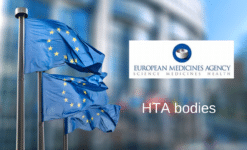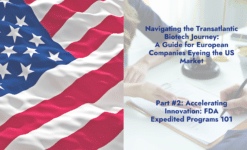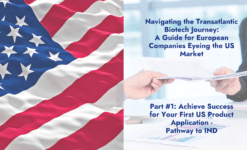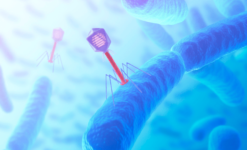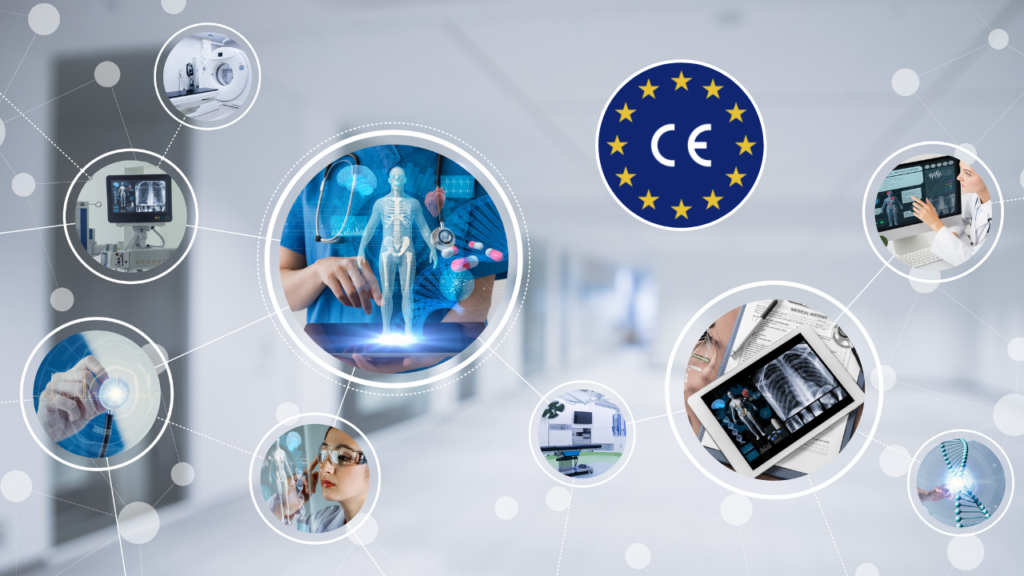
In the European Union (EU) the review and approval of medical devices and in vitro diagnostic medical devices often requires the involvement of Notified Bodies. A Notified Body is an organization responsible for issuance of the CE-certification for medical device products, or medical technologies (MedTech).
Products which require a CE-marking include:
- Medical devices of risk class IIa to III.
- Medical devices in sterile conditions and/or having a measuring function.
- In vitro diagnostic devices of risk class A sterile, B, C and D.
Here, we cover all the most important information for MedTech innovators and manufacturers to understand the role of Notified Bodies in medical device development and how to select the correct one. This choice will be key to achieving successful commercialization of your product, reassuring investors of a good return on investment, and ensuring compliance with national regulations.
1. What is a Notified Body for Medical Device Development?
A notified body is a private organization designated by an EU country to assess the conformity of certain products before being placed on the market. Notified Bodies carry out tasks related to conformity assessment procedures set out in the applicable legislation when a third party is required.
The European Commission publishes a list of such notified bodies, which are found under NANDO (New Approach Notified and Designated Organizations). It is regularly updated with information such as newly designated Notified Bodies, scope extensions, suspensions, and terminations of Notified Bodies.
These Notified Bodies can certify for different sector categories. Examples of sectors include personal protective equipment, construction products, and pressure equipment, among others. Medical devices and in vitro diagnostic medical devices are also sectors, which are governed by Medical Device Regulation (MDR) (EU) 2017/745 and In Vitro Diagnostic Medical Device Regulation (IVDR) 2017/746, respectively. As a reminder, these regulations have recently replaced Directives 93/42/EEC, 90/385/EEC, and 98/79/EC.
Each designed Notified Body is identified by a 4-digit number on NANDO, and their number will appear on the CE-mark for any medical devices they have approved.
The number of designated Notified Bodies in the EU, falling under the recent Medical Device Regulation and In Vitro Device Regulation, is continuously increasing:
- 38 Notified Bodies are currently designated for the Medical Device Regulation.
- 10 Notified Bodies are currently designated for the In Vitro Diagnostic Regulation.
However, there are still European countries, which do not host a Notified Body under the 2017 Regulation. These include Bulgaria or Estonia. Furthermore, only 6 Member States currently host at least one Notified Body under 2017/746: Austria, France, Germany, Ireland, Netherlands, and Slovakia.
Another role of Notified bodies is to issue opinions on the medical device part of a specific type of combination product, which are composed of both medical device and medicinal components. This must be done prior to submission the medicinal marketing authorization of the medicinal component.
Indeed, Article 117 of Regulation 2017/745 is amending Directive 2001/83/EC by adding this distinct step for a category of products. This reinforces strategic considerations for the selection of notified body which should be selected on the level of their expertise for the device part which is intended to operate as a container closure system or delivery system in combination products.
2. Can any Notified Body assess the technical documentation of my medical device product?
NO.
As previously mentioned, the Notified Body should have a designation in the appropriate medical device and/or in vitro medical device sectors of NANDO.
Moreover, the particular features (i.e. design; intended purpose; technologies and processes involved…) of the device should be taken into account by the scope of designation of the Notified Body. Device features are categorized by codes, established by Commission Implementing Regulation (EU) of 23.11.2017 (Annex I and II).
For example, if the product is a non-sterile wound dressing (that would not contain any medicinal product integrated within), an appropriate code related to the assessment could be MDN 1204 (Non-active non-implantable devices for wound and skin care).
Notified bodies competencies and technical expertise for your specific device should be taken into account to contract for the review of documentation.
Notified bodies availability and capacity to accept new clients is also crucial in notified body selection. Indeed, due to the transition period between the Medical Device Directive (MDD) and Medical Device Regulation (MDR), and between the In Vitro Diagnostic medical device Directive and In Vitro Diagnosis medical device Regulation, there is an urgent challenge for certification. This is because certification is today dependent on, among other things, NB capacity. The lack of resources to perform certification of medical devices may result in the disruption of widely used devices needed by the health system and minimize the access to innovation. In this context, the Medical Device Coordination Group (also called MDCG) proposed different solutions to address this emergency. These solutions involve increased preparedness of manufacturers, better access to notified bodies, and increased notified bodies’ capacities through, for example, hybrid audits (see question 6). Recently, this transition period has been extended, providing certain conditions have been met, for example provided that the manufacturer has submitted an application to a Notified Body by the 26 May 2024 and that they have a signed formal written agreement with a Notified Body by the 26 September 2024.
Note, that the manufacturer may not have multiple notified bodies performing the assessment of the technical documentation for the same medical device. However, in the case of products in different categories (e.g. inhalators, and wound dressings), a legal manufacturer would have the freedom to enter contracts with different notified bodies for each product in their portfolio.
3. Is there a best Notified Body?
NO.
Appropriate notified body(ies) for the assessment of (a) specific product(s) should be determined on a case-by-case basis.
After the identification of competent notified bodies for a product of interest, availability to new clients and review timelines should in the current context be carefully taken into account in order to select the notified body that could respond to your needs and time constraints (see question 2).
Different factors should also come into consideration in the process of selecting a notified body (in addition to the prerequisites listed earlier):
- The language used for your technical documentation and quality management system (for the possibility and ease of the notified body to assess the documentation)
- Competencies of the notified body to audit critical supplier(s) (for example for sterilization)
- The sites in scope of the audits (language, geographical proximity, ease to come on site for the auditors)
- Experience with the type of product of the applicant, especially for products involving innovative technologies
- Relationship with the notified body (existence of a previous relationship with the NB; overall responsiveness and adaptability of the notified body)
- The fees applied by the notified body
Note that the weighting of all of the above criteria should be considered carefully as part of the selection of a Notified Body. For example, availability can be more critical than pricing as certification involves sometimes very long waiting times and processes (complete certification could last in total 1-2 years). In this case, choosing the most appropriate Notified Body could help manufacturers and innovators to save time and consequently, save money.
Lastly, when planning an expansion to other geographical areas such as Canada, Australia, Brazil, Japan, and US, you may like to consider a notified body that is also able to support the Medical Device Single Audit Program (MDSAP). A few European notified bodies are engaged in this program since its launch: e.g. DEKRA Certification B.V, NSAI, DQS Medizinprodukte GmbH, etc. The list of Recognized Auditing Organizations to conduct audits and issue MDSAP certificates can be found on the FDA website.
4. Are Notified Bodies recognized in non-EU countries?
SOMETIMES.
Since the non-renewal (May 2021) of their Mutual Recognition Agreement, EU and Switzerland are now third parties to each other. Swiss medical devices are regulated under Medical Device Ordinance (MedDO) which largely takes up Medical Device Regulation notions. In certain cases, certificates established in a region may be recognized in Switzerland provided specific requirements are met.
Since the Brexit, it was decided that CE-marking will no longer be recognized in the United Kingdom (UK) after July 2024. For marketing in the UK, manufacturers will have to follow another process, the UK conformity Assessment (UKCA under UK Medical Devices Regulations 2002 (SI 2002 No 618, as amended) (UK MDR 2002) marking and will have to designate a UK Responsible Person for all device manufacturers. Previous notified bodies located in the UK cannot issue CE certificates anymore. Medicines and Healthcare products Regulatory Agency regulates medical devices in the UK. There are now 4 UK approved conformity assessment bodies. There are now 4 UK approved conformity assessment bodies.
In Northern Ireland, CE-marking is required. Specific rules apply to Great-Britain (England Wales and Scotland) manufacturers, and UK conformity assessment bodies are not recognized.
Note that a notified body can only be located in the EU, but due to some Mutual Recognition Agreements or treaties with the European Union, other entities outside of the EU can operate as a notified body. For the medical device sector, according to NANDO website, Mutual Recognition Agreements are effective in Australia, Switzerland and New-Zealand. Moreover, although being headquartered in the EU, notified bodies can have a subsidiary outside the EU, to better serve their international clients.
5. Can I transfer my products to another Notified Body?
MAYBE
For medical devices, the “transfer process” is understood as transferring a CE-marking certificate issued by a notified body to another notified body, without starting over the certification process, but without bringing any other changes to the CE certificate. Following this transfer, the incoming notified body endorses the whole responsibility for the “new” conformity assessment.
A tripartite agreement is highly recommended with the current (outgoing) notified body, the selected (ingoing) notified body to transfer the CE certificate to, and the legal manufacturer. A transfer agreement contract template proposed by The European Association Medical devices of Notified Bodies (TEAM-NB) is availablex and can be considered for reference. In a few words, according to the Medical Device and In Vitro Diagnostic medical device Regulations, the contract should contain:
- the end date of outgoing notified body certificate
- the closing date for indication of outgoing notified body identification number in information supplied by the manufacturer (including promotional material)
- the transfer of documents (including confidentiality aspects and property rights)
- the date of conformity assessment assignment to the incoming notified body
- the last (device) serial/lot number under outgoing notified body responsibility
As raised by MDCGxi, conformity assessment activities that the incoming notified body should perform depend on the available/sufficient information related to the outgoing notified body conformity activities. The incoming notified body will have to perform on-site audit(s) to ensure that the Quality Management System and Post-Market Surveillance Plan activities as defined in the original certification process are applied. The incoming notified body should verify the previous assessment results based on sampling basis. New certificates may be issued without a complete initial review if no concerns are identified by received documentation.
Naturally, there are specific limitations for a manufacturer to be eligible to use this process, e.g.:
- The certificate should not be under suspension
- The expiration of the certificate should not occur within the six months before the transfer could occur
- No major complaints or vigilance events since the last certification audit
6. Can audits be performed remotely?
YES AND NO.
Audits may be conducted remotely, provided that hybrid audits requirements are met such as, as defined by TEAM-NB:
- Audit team qualification (Annex VII section 3.2.6 of MDR/IVDR): in case on-site auditor does not cover all required qualifications, they can be supported through communication technologies by appropriately qualified auditor(s) (with potential additional time for concerned processes review).
- Manufacturer’s capability to support hybrid audits (IT systems, electronic vs. paper-based documentation etc.).
- Audit duration based on International Accreditation Forum Mandatory Documents
Whereas certain areas should be audited on-site (infrastructure, work environment, production inspection, servicing, warehouse, etc.), some domains can be effectively audited remotely (management including regulatory affairs, improvement including CAPAs, human resources including trainings, purchasing including supplier files, etc.). Moreover, hybrid audits could provide advantages for the notified bodies and in extension, for the manufacturers (potential savings in audit capacity, increased documentation assessment effectiveness, reduced logistic constraints regarding travelling and accommodation, etc.)
In exceptional cases, the audit may be performed fully remotely (where there is no physical location to visit), with specific verifications (e.g. confirmation of absence of physical handling of the product).
References:
- Regulation (EU) 2017/746 of the European Parliament and of the Council of 5 April 2017 on in vitro diagnostic medical devices and repealing Directive 98/79/EC and Commission Decision 2010/227/EU. Link
- Commission implementing Regulation of 23/11/2021 on the list of codes and corresponding types of devices for the purpose of specifying the scope of the designation as notified bodies in the field of medical devices under Regulation (EU) 2017/745 of the European Parliament and of the Council and in vitro diagnostic medical devices under Regulation (EU) 2017/746 of the European Parliament and of the Council. Link
- EUROPA – European Commission – Growth – Regulatory policy – NANDO Link
- EUROPA – European Commission – Growth – Regulatory policy – NANDO Link
- Commission implementing Regulation of 23/11/2021 on the list of codes and corresponding types of devices for the purpose of specifying the scope of the designation as notified bodies in the field of medical devices under Regulation (EU) 2017/745 of the European Parliament and of the Council and in vitro diagnostic medical devices under Regulation (EU) 2017/746 of the European Parliament and of the Council
- MDCG 2022-14, MDCG Position Paper, Transition to the MDR and IVDR, Notified body capacity and availability of medical devices and IVDs (August 2022). Link
- REGULATION (EU) 2023/607 OF THE EUROPEAN PARLIAMENT AND OF THE COUNCIL of 15 March 2023 amending Regulations (EU) 2017/745 and (EU) 2017/746 as regards the transitional provisions for certain medical devices and in vitro diagnostic medical devices
- Proposal for a REGULATION OF THE EUROPEAN PARLIAMENT AND OF THE COUNCIL amending Regulations (EU) 2017/745 and (EU) 2017/746 as regards the transitional provisions for certain medical devices and in vitro diagnostic medical devices (January 2023). Link
- Medical Devices Ordinance of 1 July 2020 (MedDO SR 812.213) and Amendment of the completely revised Medical Devices Ordinance (MedDO; status as of 26 May 21). Link
- TRANSFER AGREEMENT specifying the terms of voluntary change of notified body under Regulation (EU) 2017/745 or Regulation (EU) 2017/746 (Version 1 – 5/10/2022)
- MDCG 2019-6 Rev4, Questions and answers: Requirements relating to notified bodies (Revision 4 – October 2022). Link
- Notified bodies’ paper on the application of hybrid audits to quality management system assessments under MDR/IVDR (Version 1 – September 26th, 2022). Link
- IAF MD 5:2019 Determination of Audit Time of Quality, Environmental, and Occupational Health & Safety Management Systems, Issue 4 Version 2. Link
- IAF MD 9:2017 Application of ISO/IEC 17021-1 in the Field of Medical Device Quality Management Systems (ISO 13485), Issue 3 Version 1. Link
Published on: April 27, 2023

